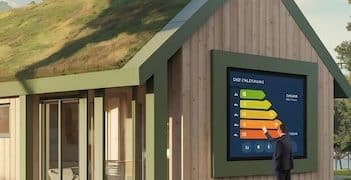Maximize Savings: Federal Tax Credits for Energy-Efficient Windows Before 2026

New Federal Tax Credits for Energy-Efficient Windows: Act Before 2026 offer homeowners a valuable opportunity to reduce their tax burden while investing in energy-efficient home improvements, specifically new windows, contributing to both environmental sustainability and significant cost savings.
Unlock significant tax benefits by upgrading to energy-efficient windows! The new federal tax credits for energy-efficient windows: Act Before 2026 are here to help homeowners like you save money while making environmentally conscious choices.
Understanding the Energy-Efficient Home Improvement Credit
The energy-efficient home improvement credit, established under the Inflation Reduction Act of 2022, provides a significant financial incentive for homeowners who invest in qualifying energy-efficient upgrades. This credit aims to encourage energy conservation and reduce the overall carbon footprint of residential buildings.
Let’s delve deeper into the specifics of this credit and how it can benefit you when upgrading your windows.
What Qualifies as an Energy-Efficient Window?
To qualify for the tax credit, windows must meet specific energy-efficiency standards set by the Energy Star program. These standards vary by climate zone but generally require windows to have low U-factors and solar heat gain coefficients (SHGC). The U-factor measures how well a window insulates, while the SHGC measures how much solar heat enters the home through the window.
Maximum Credit Amount and Claiming Process
The energy-efficient home improvement credit covers 30% of the cost of qualified expenses, including installation costs, up to a maximum of $1,200 per year for all building envelope components, including windows, doors, insulation, and roofing. To claim the credit, you’ll need to file IRS Form 5695 with your tax return. Keep detailed records of your purchase and installation costs, as well as the Energy Star certification information for your new windows.
- Confirm the windows meet Energy Star requirements for your climate zone.
- Keep all receipts and documentation related to the purchase and installation.
- File IRS Form 5695 with your tax return to claim the credit.
The energy-efficient home improvement credit is a valuable tool for homeowners looking to reduce their energy consumption and improve the comfort of their homes. By understanding the eligibility requirements and claiming process, you can take advantage of this incentive and enjoy long-term savings on your energy bills.
Eligibility Requirements for the Tax Credit
Understanding the eligibility requirements is crucial to ensure that your window replacement project qualifies for the federal tax credit. These requirements are specific and designed to promote genuine energy efficiency.
Let’s break down the key criteria you need to meet to take advantage of this incentive.
Homeowner Requirements
To be eligible for the tax credit, you must be a homeowner who owns and resides in the property where the windows are being installed. The credit applies to existing homes and not new construction. Rental properties do not qualify.
Product Requirements
The windows you purchase must meet the Energy Star requirements for the climate zone in which you live. Energy Star-certified windows are independently tested and certified to meet specific energy-efficiency criteria. Check the Energy Star website for the most up-to-date requirements and qualifying products.

Installation Requirements
The tax credit covers both the cost of the windows and their installation. It’s essential to have the windows professionally installed to ensure they perform as intended and meet the required energy-efficiency standards. Proper installation can prevent air leaks and other issues that can reduce energy savings.
- Ensure you are the homeowner and the property is your primary residence.
- Verify that the windows meet Energy Star requirements for your climate zone.
- Use a qualified professional for the installation to ensure proper performance.
By carefully reviewing and meeting these eligibility requirements, you can confidently move forward with your window replacement project and claim the federal tax credit, saving money while improving your home’s energy efficiency.
Benefits of Upgrading to Energy-Efficient Windows
Upgrading to energy-efficient windows provides a multitude of benefits, extending beyond just tax credits. These benefits encompass financial savings, improved home comfort, and environmental contributions.
Let’s explore the advantages of investing in energy-efficient windows to help you make an informed decision.
Reduced Energy Bills
Energy-efficient windows significantly reduce heat transfer, keeping your home warmer in the winter and cooler in the summer. This can lead to substantial savings on your heating and cooling bills, as your HVAC system doesn’t have to work as hard to maintain a comfortable temperature.
Enhanced Home Comfort
Energy-efficient windows help eliminate drafts and cold spots, creating a more consistent and comfortable indoor environment. They also reduce condensation, which can lead to mold and mildew growth, improving indoor air quality.
Increased Home Value
Upgrading to energy-efficient windows can increase the value of your home. Potential buyers appreciate the benefits of lower energy bills and improved comfort, making your home more attractive in the real estate market.

Environmental Benefits
By reducing your energy consumption, energy-efficient windows help lower your carbon footprint. This contributes to a more sustainable environment and supports efforts to combat climate change.
- Save money on heating and cooling costs with lower energy bills.
- Enjoy a more comfortable and consistent indoor temperature year-round.
- Increase the resale value of your home with desirable energy-efficient upgrades.
Investing in energy-efficient windows is a win-win situation. You’ll enjoy immediate financial benefits, improved comfort, and long-term environmental advantages. Consider these factors when planning your next home improvement project.
Navigating the Inflation Reduction Act
The Inflation Reduction Act of 2022 has significantly impacted the availability and terms of energy-efficient home improvement tax credits. Understanding these changes is vital for homeowners looking to capitalize on these incentives.
Let’s examine how this act has reshaped the landscape of energy efficiency tax credits.
Key Provisions of the Act
The Inflation Reduction Act reinstated and expanded the energy-efficient home improvement credit, making it more accessible and beneficial for homeowners. It increased the maximum credit amount and extended the credit through 2032, providing long-term certainty for those planning energy-efficient upgrades.
Impact on Window Tax Credits
The act specifically addresses windows by including them as qualified energy-efficient improvements. This means that homeowners who install Energy Star-certified windows can claim 30% of the cost, up to $1,200 annually. This provision encourages homeowners to invest in high-performance windows that meet stringent energy-efficiency standards.
Future Implications
The Inflation Reduction Act signals a long-term commitment to promoting energy efficiency and reducing carbon emissions. Homeowners who take advantage of these tax credits not only save money but also contribute to a more sustainable future. As energy costs continue to rise, the value of these incentives will only increase.
- Understand the enhanced tax credit amounts and extended availability through 2032.
- Recognize that the act specifically includes windows as qualified improvements.
- Consider the long-term benefits of investing in energy efficiency.
The Inflation Reduction Act has created a favorable environment for homeowners looking to improve their homes’ energy efficiency. By understanding the key provisions and implications of this act, you can make informed decisions and maximize the benefits of available tax credits.
Steps to Take Before 2026
With the clock ticking towards 2026, it’s essential to take strategic steps to ensure you maximize your savings through the federal tax credits for energy-efficient windows. This involves planning, selecting the right products, and proper documentation.
Let’s outline the actionable steps you should take now to benefit from these incentives.
Assess Your Window Needs
Begin by assessing the condition of your current windows and identifying areas where energy efficiency can be improved. Look for signs of drafts, condensation, and excessive heat transfer. A professional energy audit can provide valuable insights and recommendations.
Research Energy Star-Certified Windows
Thoroughly research Energy Star-certified windows that meet the requirements for your climate zone. Compare U-factors, SHGC ratings, and other performance metrics to find the best options for your home. Consider factors such as window material, frame type, and glass options.
Obtain Quotes from Qualified Installers
Obtain quotes from multiple qualified window installers. Ensure that the installers are licensed, insured, and experienced in installing energy-efficient windows. Ask for references and review their past work to ensure quality and reliability.
Schedule Installation Before the Deadline
Schedule the installation of your new windows well before the end of 2025 to allow ample time for the project to be completed and for you to gather the necessary documentation for your 2025 tax return. Delays can occur due to weather, product availability, and installer scheduling, so it’s best to plan ahead.
- Evaluate your current windows and identify areas for improvement.
- Research and select Energy Star-certified windows that meet your needs.
- Get quotes from qualified installers and schedule installation promptly.
By taking these steps now, you can ensure that you’re well-positioned to take advantage of the federal tax credits for energy-efficient windows before the 2026 deadline. Don’t wait – start planning your project today!
Common Mistakes to Avoid
When pursuing federal tax credits for energy-efficient windows, it’s important to be aware of common mistakes that can jeopardize your eligibility. Avoiding these pitfalls will help ensure that you receive the tax credits you deserve.
Let’s highlight the common errors and how to steer clear of them.
Incorrect Window Selection
One of the most common mistakes is selecting windows that don’t meet the Energy Star requirements for your specific climate zone. Always verify that the windows you choose are certified and meet the required U-factor and SHGC ratings.
Improper Installation
Improper installation can significantly reduce the energy efficiency of your windows and may disqualify you from receiving the tax credit. Always use a qualified and experienced installer who follows best practices and manufacturer recommendations.
Inadequate Documentation
Failing to maintain adequate documentation is another common mistake. Keep detailed records of your purchase and installation costs, as well as the Energy Star certification information for your windows. This documentation is essential when filing your tax return.
Missing the Deadline
Procrastination can lead to missing the deadline for claiming the tax credit. Plan your project well in advance and ensure that installation is completed and documentation is gathered before the end of the tax year.
- Double-check that your selected windows meet Energy Star requirements for your climate zone.
- Hire a qualified installer to ensure proper installation and performance.
- Maintain thorough documentation of your purchase, installation, and Energy Star certification.
By being mindful of these common mistakes and taking proactive steps to avoid them, you can increase your chances of successfully claiming the federal tax credits for energy-efficient windows. Stay informed and organized throughout the process.
| Key Point | Brief Description |
|---|---|
| 💰 Tax Credit | 30% of costs, up to $1,200 per year for energy-efficient home improvements. |
| ⭐ Energy Star | Windows must meet Energy Star requirements for your climate zone to qualify. |
| 🏡 Homeowner | You must own and reside in the property. Rental properties don’t qualify. |
| 📅 Deadline | Act before 2026 to claim the tax credits for window upgrades. |
FAQ
▼
Energy Star requirements vary by climate zone, focusing on U-factor and SHGC ratings to ensure optimal energy efficiency for your region.
▼
No, the tax credit is only available for homeowners who reside in the property where the windows are installed, not for rental properties.
▼
You need detailed receipts of purchase and installation costs, along with Energy Star certification data for the windows, and IRS Form 5695 filed with your tax return.
▼
While not explicitly required, professional installation ensures the windows perform as intended, meeting energy efficiency standards for the tax credit.
▼
To claim the tax credit, the window installation must be completed and the credit claimed on your tax return before the 2026 deadline, so plan accordingly.
Conclusion
In conclusion, the federal tax credits for energy-efficient windows offer a significant opportunity for homeowners to save money, improve home comfort, and contribute to a more sustainable environment. By understanding the eligibility requirements, taking strategic steps, and avoiding common mistakes, you can maximize your savings and enjoy the long-term benefits of energy-efficient windows. Act now before the 2026 deadline to take advantage of this valuable incentive.





